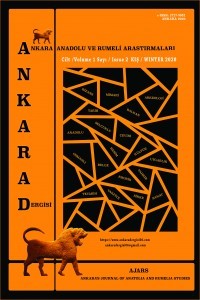OSMANLI NÜFUS SAYIMI VERİLERİNDE MAHALLELER: LEFKOŞE AYASOFYA MAHALLESİ ÖRNEĞİ (1831-1839)
Lefkoşe Ayasofya Mahallesi sadece Müslümanların ikamet ettiği mahallelerden biri olmuştur. Hicrî 1246 (1830/31) nüfus sayımında ve sonraki yıllarda yapılan sayımlarda adı geçen mahallenin erkek nüfusu 396’dan 436’ya kadar çıkmıştır. Mahalle sakinlerinin doğumla kazandıkları göreceli nüfus artış ivmesi ölüm oranlarındaki nispi fazlalıkla kaybolmuştur. Buna mukabil Lefkoşe’nin Gayrimüslim mahallelerinde hem doğum hem de ölüm oranlarında nispi düşüklük tespit edilmiştir. Bu çalışmada söz konusu mahalle sakinlerinin isimleri irdelenmiş ve erkek nüfusun yaklaşık beşte birinin Mehmed ismini taşıdığı görülmüştür. Mehmed ismini Mustafa ismi takip etmiştir. Hz.Peygamberin diğer bir ismi olan Ahmed de sözü edilen mahallede en çok rağbet gören isimler arasında yer alsa da Hüseyin ile Hz. Muhammed arasındaki dede-torun ilişkisi Hüseyin isminin Ahmed isminden önce gelmesine neden olmuştur. Ali, Hasan, Hüseyin gibi Ehl-i Beyt isimleri hem Sünni hem de Sünni olmayanların sıklıkla rağbet ettiği isimler olmuştur. Ayasofya mahallesinde toplam 53 çeşit meslek çeşidi tespit edilmiştir. 436 kişilik nüfusun 180'i bir meslek grubuna veya bir memuriyete mensup olmuştur. Bir çeşit memuriyet olan sipahilik 23 kişiyle mahallede en çok rağbet gören hizmet alanı olmuştur. Sipahilikten sonra en çok tercih edilen meslek ise 17 kişiyle pabuççu mesleği gelmiştir. Üçüncü sırada basmacılar yer almıştır. İradi esasa dayanmadığı için meslek sayılmayan kölelik ile memur sınıfına daha yakın duran zeamet erbabı ilk üç mesleği takip etmiştir. Diğer meslek grupları ağırlıklı olarak ikişer ve birer kişiyle temsil edilmiştir. Ayasofya’da ikamet edenlerin 46’sı söz konusu nüfus sayımlarında tuvânâ yazılmıştır. Askerlik hizmetini ifa etme yaşına girmiş genç kişi anlamına gelen tuvânâ kayıtlarında asgari ya da azami bir yaş sınırı tespit edilememiştir. Tuvânâ kaydı 12-18 yaş aralıklarında değişiklik göstermiştir. Askerliğe celp yaşının farklılık arz etmesi ailenin içinde bulunduğu sosyal ve ekonomik durumunun, gençlerin sıhhat ve vücut yapılarının önemli bir rol oynadığı düşünülmüştür. Ayasofya mahallesinde askeri hizmetten muaf tutulup müsin yazılanların sayısı 24 olmuştur. Böylece Osmanlı Devleti, en küçük idari birim olan mahallelerde nüfus sayımı yaparak ihtiyaç anında ne kadarlık askeri bir güce sahip olduğunu önceden kestirebilmeyi hedeflemiştir.
Anahtar Kelimeler:
Osmanlı, Nüfus sayımı, Lefkoşe, Tuvânâ, Müsin
NEIGHBORHOODS IN OTTOMAN POPULATION CENSUS DATA: A CASE STUDY OF NICOSIA AGHIA SOPHIA NEIGHBORHOOD (1831-1839)
Ayasofya neighborhood was one of the neighborhoods where only Muslims resided. From the census of Hijri 1246 (the year 1830-1831) to the censuses of the following year the male population of the neighborhood rose from 396 to 436. High birth rate of the Ayasofya neighborhood was compansated by the high death rate such that the population remained mostly stable. While the populations of nonmuslim neighborhoods in Lefkoşe remained stable due to a low birth and death rate. In this study, upon analyzing the names of the Ayasofya neighborhood residents, it was found that approximately one fifth of the male population was named Mehmed. The name Mehmed was followed by the name Mustafa in popularity. Ahmed, which is another name of Prophet Muhammed, was also a popular name; however, the name Hüseyin which belonged to the grandson of the Prophet Muhammed was more popular than Ahmed due to the value given to the special grandson grandfather relationship Hüseyin had with the Prophet. It was hypothesized that the names of the residents reflected to which Islamic sect they belonged. Names from the Ehl-i Beyt such as Ali, Hasan, Hüseyin are used both by Sunni and non Sunni Muslims. A total of 53 different occupations were observed in the records of the Ayasofya neighborhood. Out of a population of 436 people 180 were part of an occupational group or were civil servants. Being spahi (cavalary soldier), which was a kind of civil service, was the most popular occupation with a total of 23 residents. It was followed by shoemaking which 17 people in the neighborhood did. Third most popular occupation was being a cloth merchant. These occupations were followed by farmers (specifically zeamet model) and gholams (note: this is a kind of slavery model and not considered an occupation in the same way since it is not based on free volition). The other occupations were mostly represented by one or two people. 46 of the residents were recorded as being tuvana. Tuvana means a young male who is of enlistment age. While there was not an official age bracket for the enlistment age in the records, the young males who were recorded as being of enlistment age were between the ages of 12 and 18. The variation in the ages is most likely due to the socio economic status of each family as well as the health and physique of any given young man. There were 24 men who were recorded as müsin, or too old to serve in the military. By taking population censuses of neighborhoods, the smallest administrative units, Ottoman Empire aimed to estimate its military capacities.
Keywords:
Ottoman, , Nicasia, Tuvana (Strong), Müsin (Aged),
___
- Evangelia Balta, Filiz Yaşar, Elif Bayraktar, “Gayr-i Muslims in Tuzla (Larnaca): The Census Register of 1831”, in: Histories of Ottoman Larnaca, (eds) Evangelia Balta, Theocharis Stavrides, Ioannis Theocharides, Istanbul, The Isis Press, 2012.
- Evangelia Balta, Mesut Ayar, “Ottoman Larnaca in the age of Reforms: A Study of the Temettuat Register (1833)”, in: Histories o f Ottoman Larnaca, (eds) Evangelia Balta, Theocharis Stavrides, Ioannis Theocharides, Istanbul, The Isis Press, 2012.
- Evangelia Balta, Mustafa Oğuz, “Musims in Tuzla (Larnaca). The Census Register TŞR.KB.d. 40”, in: Festschrift in Honor of Ioannis P. Theocharides. Studies on Ottoman Cyprus (eds) Evangelia Balta, Georgios Salakidis, Theocharis Stavrides, Istanbul, The Isis Press, 2014.
- ISSN: 2717-9052
- Yayın Aralığı: Yılda 2 Sayı
- Başlangıç: 2020
- Yayıncı: Ankara Üniversitesi
Sayıdaki Diğer Makaleler
OSMANLI NÜFUS SAYIMI VERİLERİNDE MAHALLELER: LEFKOŞE AYASOFYA MAHALLESİ ÖRNEĞİ (1831-1839)
ANKARA’DA GAYRİMÜSLİM TÜCCARLAR VE SOF TİCARETİ (XVII. YÜZYIL)
Mahmut Halef CEVRİOĞLU, Çevirmen: Mahmut Halef CEVRİOĞLU
VİDİN LİVASINA BAĞLI İSFERLİK NÂHİYESİNE AİT XV. YÜZYIL MUFASSAL DEFTERİ PARÇASI
OSMAN NİZAMİ PAŞA, İTALYAN ORDUSU ALBÜMÜ, H.1303 (1885-1886)
Meryem BATAN, Çevirmen: Meryem BATAN
VAKIF VE MEKÂN İLİŞKİSİ BAĞLAMINDA ANKARA’NIN HAYIRSEVER KADINLARI NASIL ANLAMLANDIRILABİLİR?
ARŞİV BELGELERİ IŞIĞINDA OSMANLI DEVLETİ VE BUHARA EMİRLİĞİ ARASINDAKİ HEDİYELEŞME
